Stockton Volunteers with N.J. Osprey Project to Monitor Nests
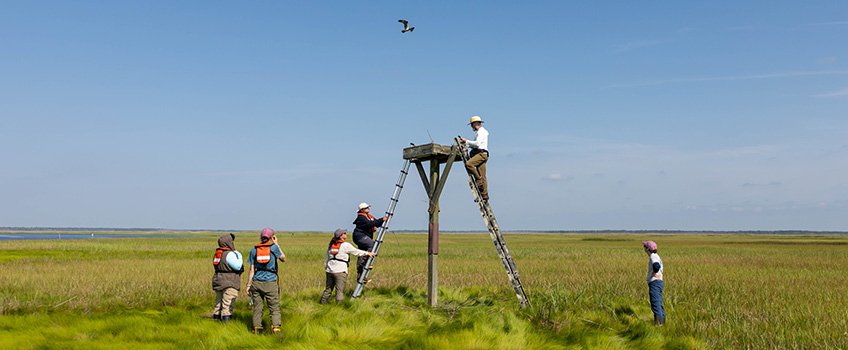
A team from Stockton University watches Ben Wurst, of the Conserve Wildlife Foundation of New Jersey, band osprey chicks.
Port Republic, N.J. - When Stockton University’s R/V Skimmer drifted to an osprey nesting platform on the edge of the marsh, an adult took flight from the wooden box that had lost most of its nesting material in a storm the previous night.
The anxious parent sounded alarm calls as it flew overhead, eyes locked on Melanie Schroer, an instructor of Biology, and Ben Wurst, a senior wildlife biologist for the Conserve Wildlife Foundation of New Jersey.
Schroer cautiously stepped through the vibrant green cordgrass, looked down and found a displaced chick covered in tiny pin feathers that were still growing in. Wurst found a second chick nearby.
“They have full crops,” he said, pointing to a bulging pouch holding the chick’s last meal before it enters the stomach.
Student volunteers Tatiana Anderson, Tanya Sharma and Breanna Hawkins got off the boat to get a closer look at the rescued chicks and to help rebuild the nest.
Dave Ambrose, a Field Station assistant, quickly filled his arms with enough dried reeds to bolster the nest.
Hawkins and Sharma held the fragile birds and noticed all the details up close — an egg tooth used to break out of the shell on the tip of the beak, little nostrils and blood orange eyes that mostly wanted to stay shut.
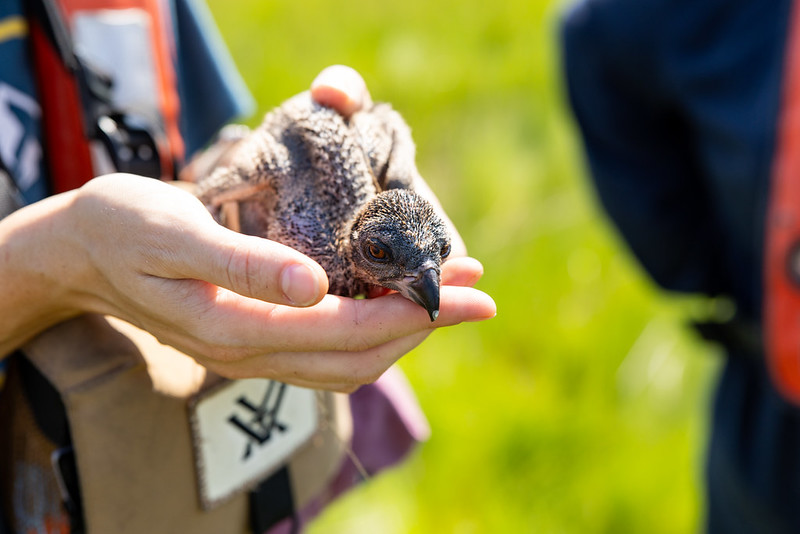
Wurst placed a ladder against the platform and climbed up to return the chicks to the nest along with two bunker fish to help the parents with their next feeding.
The team returned to their boats to go to the next nest but lingered until they saw the parent return to the chicks.
If the survey took place a day or so later, the chicks would have died, said Wurst.
Stockton Volunteers with New Jersey Osprey Project
The osprey was listed as an endangered species in New Jersey in 1974, just a few years after Stockton became a college and chose the fish hawk as its mascot. The banning of DDT, an insect pesticide, and years of conservation efforts resulted in the osprey’s removal from the state’s list of endangered species this year, changing its status from threatened to stable.
Population monitoring is key to ensuring continued success.
Schroer, who is working on her Ph.D. with the University of Birmingham, knew she wanted to focus on birds for her conservation research and looked for a local species with a history of data she could contribute to.
She met Wurst and accompanied him on an osprey banding trip last summer. The learning experience led her to the New Jersey Osprey Project where she is now monitoring 30 nests regularly along the Mullica River with student volunteers.
Across the state, there are more than 800 nesting pairs of ospreys, up from the all-time low of about 50 in the 1970s.
Schroer partnered with the Stockton Marine Field Station to conduct spring and summer surveys at the nesting platforms that are only accessible by boat.
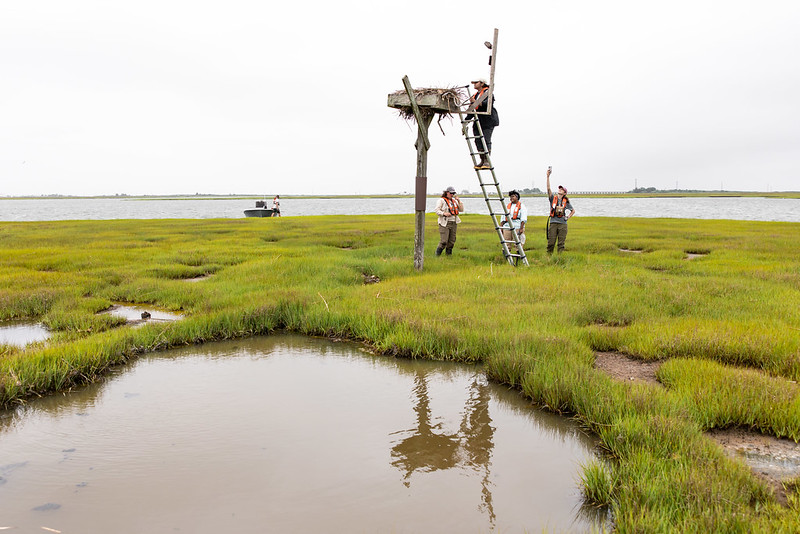
At each nest, the team records whether the nest is occupied and active, how many young are present, and notes the presence of plastic and debris in the nest.
The nest boxes are raised about 10 feet in the air, so Schroer worked with Andrew Genovese, a junior Biology major from Egg Harbor Township, to design a bird watching selfie stick that uses a cell phone to get imagery of what’s inside the nest without being too disruptive to the birds.
Osprey Selfies
A Strong Start Turns into Nest Failures and Brood Reduction
Preliminary observations this season are showing instability, and Stockton’s observations are consistent with incoming data from volunteers across the state.
Adult ospreys returned this spring to nest, but they're losing chicks. “Nobody can really point a finger and say it's definitely one thing or the other at this point,” Schroer said.
But she added, “Many of the outcomes point to food availability as the primary culprit, but we need to investigate more, because reproductive outcomes are influenced by so many variables that interact in complex ways. It's really this complexity that I'm trying to unravel in my research.”
During the June 26 survey, 20 nests along the Mullica River were monitored. Half were active with either eggs or chicks, but three saw brood reduction, or a loss of chicks, since the previous survey in May. The other half were failed nests with all chicks or eggs lost.
“Ospreys are most vulnerable to weather, food availability and predation for the first few weeks after hatching,” Schroer explained.
Seven of the 10 failed nests failed since the May survey during this vulnerable period.
Bunker Fish Delivery
“It was sad and disheartening to see so many empty nests that were previously documented as having chicks or eggs,” said Breanna Hawkins, a senior Environmental Studies and Language and Culture Studies major from Michigan.
She also noted the diversity in nest building by various pairs. “You’ve got the try-hard parents who have a 2-foot-tall stack of sticks for their nest and then you've got the parents that are very simple, like, less is best,” she said.
Understanding the Overall Picture
Schroer has some of her own questions beyond what the survey data can illustrate.
“I'm trying to figure out the relative impacts of diet, competition with other animals and predation by other animals,” she said.
What are they eating? How often are they eating? Is it enough for their babies?
“A lot of evidence points to food stress as the driver of brood reduction or the loss of offspring and nest failure, but what are the factors that keep osprey parents from returning to the nest with enough food to sustain their growing nestlings?” she asked.
She cited smaller and more distant fish populations and extreme weather, but another factor may be interactions with other predator species.
Bald eagles practice kleptoparasitism, or piracy, by chasing after other birds that have successfully made a catch and trying to steal their prey.
Remote Camera Footage Offers Bird’s-Eye Views
Finding answers to her questions means getting creative with 24/7 surveillance. In March, Schroer and Genovese installed decoy cameras on nesting platforms.
Remote cameras that capture imagery at an interval can record what researchers wouldn’t otherwise be able to observe.
Having the fake cameras installed prior to the ospreys’ return was key. If the cameras were placed after the birds began nesting, the foreign object could trigger them to abandon the nest.
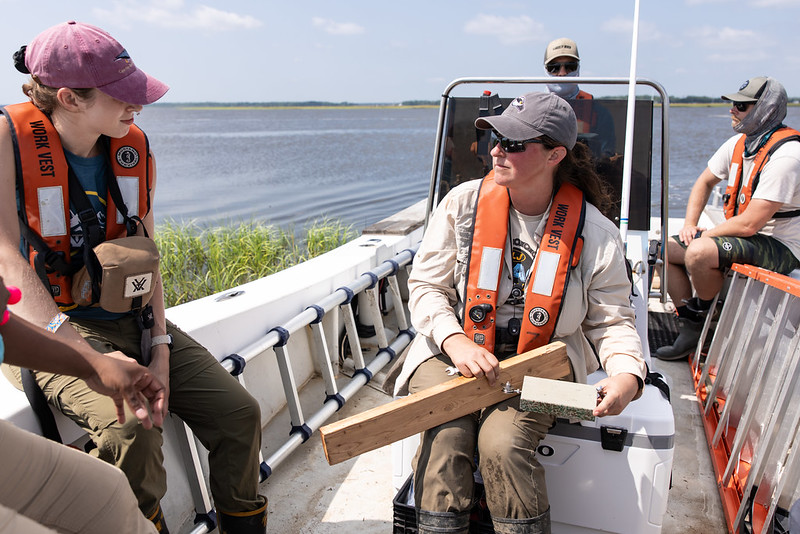
“There was one nest earlier this season that had an egg and then it was predated, so we used camera data to narrow it down to the different species that could have been responsible,” she said.
The event wasn’t captured on film, but there is footage of gulls, crows and a bald eagle at the nest, which narrows down the culprit.
This is a pilot year for the camera project, so Schroer is fine tuning the camera settings and the shooting interval. Sifting through hours of footage is revealing pieces of each osprey family’s complex lives.
Field Work Opportunity Turns Students into Birders
When Tanya Sharma, a senior Biology major from Mays Landing, emailed her professor about a letter of recommendation, she never imagined she’d end up in the middle of a saltmarsh trekking through mud almost strong enough to pull off her rubber boots.
Schroer invited her to join an osprey survey. Although her focus is pre-med, Sharma asked herself, “Why not? I’m always open to any experience I can get.”
Prior to this year, she’d never been on a saltmarsh or felt the wind rushing by her while boating let alone held a once-endangered species in the palms of her hands.
“I did it, and it was so much fun,” she said, admitting she’d never done anything like it before.
The field work opportunity already has her paying more attention to birds.
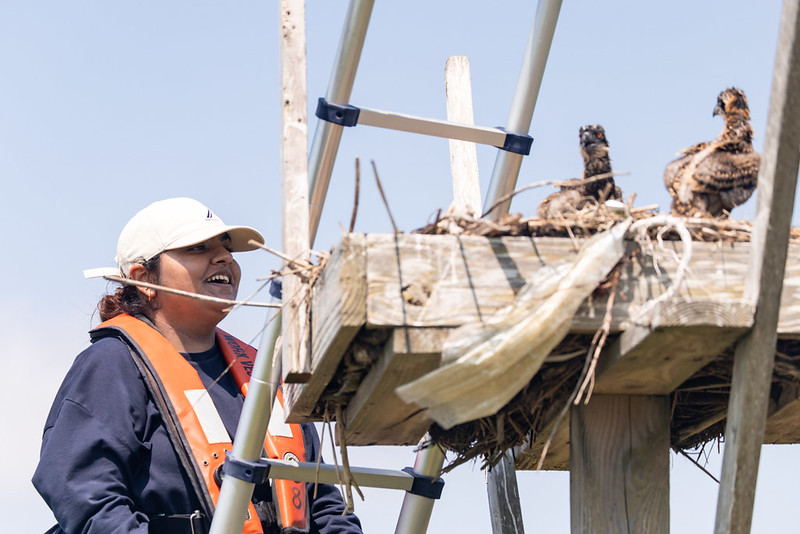
The survey was also a first-time experience for Genovese.
“A very memorable moment was seeing osprey chicks after waiting for them to hatch. Being involved with this research has been one of my most memorable experiences at Stockton. I'm extremely grateful for it and am looking for more chances to do similar work in the future,” he said.
Hawkins, founder of Stockton’s Pine Barrens Birding Club, was already a birder, but had never had an experience that brought her up close with osprey chicks in a nest.
Tatiana Anderson, a junior Marine Science major from Riverside, dreams of working with cephalopods, but she’s also open to gaining as much experience as possible with other creatures.
“When I hear about volunteer and research work, I hop on it immediately to get a well-rounded experience,” she said.
Stockton students interested in getting involved with Schroer’s research, can connect with her via email at Melanie.Schroer@Stockton.edu.
Story and photos by Susan Allen


